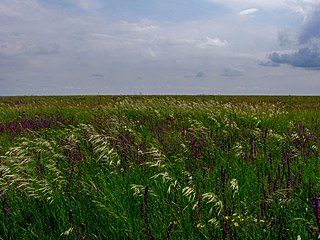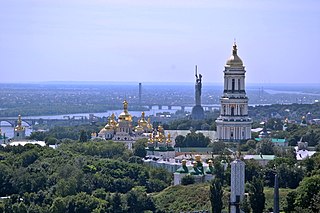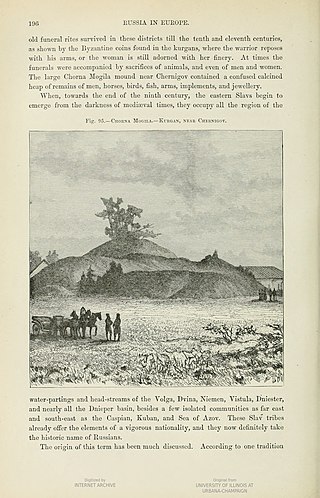The Coastal Reserve was a former conservation area in Ukraine that was under protection from 1930 to 1933. It was primarily a bird sanctuary and officially became part of the Askania-Nova reserve in 1933.
The Coastal Reserve was a former conservation area in Ukraine that was under protection from 1930 to 1933. It was primarily a bird sanctuary and officially became part of the Askania-Nova reserve in 1933.
H. A. Bryzhalin proposed the idea of creating bird sanctuaries in Ukraine in 1919, along the shores of the Black Sea and the Azov Sea. Bryzhalin was inspired by examples of similar American bird sanctuaries and reserve areas.
On July 14, 1927, the Soviet resolution Narodnykh kommisarov, or SNK USSR No. 172, was adopted to "protect the natural environment of the Black Sea and the Azov Sea", including the "defense of birds" from predators during flight and nesting. The reserve area included Churyuk Island in the Syvash, Dzharylhach Island in the Black Sea, Solonoozerna dacha, and the Kinburnsʹka, Kryva, Bilosaraysʹka and Obitochna Spits. The total area of the reserves covered 32,000 hectares of coastal ecosystems along the coastline of the Black Sea and The Sea of Azov. The term "Azov Reserve", though technically incorrect, is sometimes used as an alternative to "Coastal Reserve".
Notable leaders of the 1920s environmental movement who took part in coastal reserve creation include I.Kurylo-Krimchak, director of the Melitopol Museum of Local Lore; [1] Ye.Lavrenko, Kharkiv Regional Inspector of Natural Monument Protection; and A. Brauner. [2]
By 1927, the creation of coastal reserve areas was considered the best way to protect natural monuments. [3] Many articles about reserve areas were published and many research expeditions were organized.
In the 1920s and 1930s, some parts of the reserve area were classified as independent reserves. These included the Obitochna Spit Reserve, [4] Dzharylhach Reserve, and Churyuk Island Reserve. [5] The Ukrainian Committee for Natural Monuments Protection (UCNMP) aimed to create reserve administrations and special departments for protection. Their attempts were unsuccessful. In 1928, state gravel reserve areas were established, covering a number of individual sandy areas in the lower Dnieper Valley, and in 1929, Coastal Reserve areas were discussed at gatherings of UCNMP. However, no reserve administrations were established, so by 1932, independent coastal reserves were incorporated into the Askania-Nova reserve. From January 1, 1933, Askania-Nova was divided into two regions, each an independent institution. These were the Black Sea State Reserve and the Azov-Syvash State Reserve, today known as the Black Sea Biosphere Reserve and the Azov Syvash National Nature Park.
In 1928, a detailed description of individual parts of coastal reserves was released to the public in "Protect Natural Sites in Ukraine," a book issued by UCNMP.
In 1927, on behalf of the Ukrainian Academy of Sciences, M. Sharleman led an expedition to study newly created coastal reserves. A freelance researcher from the Zoological Museum of the Ukrainian Academy of Sciences, A. K. Shepe, participated in the first excursion, which was held between June 10 and 23, 1927. The second excursion, which was held between September 3 and 14, brought on board A. K. Shepe, O. YU. Borzakovskyy, and research workers from the Chapli Reserve who had attended the previous excursion. They were the head of department of the Scientific Zoological Station, O.O. Schumer, and an entomologist, S.I. Medvedev.
In his report of the expedition, Sharleman noted the urgent need to strengthen reserve protection and educate nearby villages about environmental protection. He also acknowledged the need for a more detailed study of coastal reserves and the need for permanent research stations in reserve areas. [6] In 1928, all territory in the coastal reserves areas was intensively studied by the Odessa Regional Inspector for the Protection of Nature, V.H. Averin, [7] and ornithologists S.I Snihirevskyy [8] and L.A. Portenko. [9]
In 1932, describing the value of state coastal reserves, Sharleman noted: “The great flyways of the birds of our union are near the seaside and the islands. The protection of health-arterial routes influences greatly on the number of birds in most parts of the union.” [10] This prompted the construction of ornithological stations for studying bird migration in the coastal reserves.
The Ukrainian Committee for Natural Monuments Protection (UCNMP)
M. Sharleman in the Encyclopedia of Ukraine
Branta: Transactions of the Azov-Black Sea Ornithological Station

The geography of Ukraine varies greatly from one region of the country to another, with the majority of the country lying within the East European Plain. Ukraine is the second-largest European country, after Russia. Its various regions have diverse geographic features ranging from highlands to lowlands, as well as climatic range and a wide variety in hydrography.

The Sea of Azov is an inland shelf sea in Eastern Europe connected to the Black Sea by the narrow Strait of Kerch, and is sometimes regarded as a northern extension of the Black Sea. The sea is bounded by Russia on the east, and by Ukraine on the northwest and southwest, currently under Russian occupation. It is an important access route for Central Asia, from the Caspian Sea via the Volga-Don Canal.

Protected areas of South Australia consists of protected areas located within South Australia and its immediate onshore waters and which are managed by South Australian Government agencies. As of March 2018, South Australia contains 359 separate protected areas declared under the National Parks and Wildlife Act 1972, the Crown Land Management Act 2009 and the Wilderness Protection Act 1992 which have a total land area of 211,387.48 km2 (81,617.16 sq mi) or 21.5% of the state's area.

Ukraine used to attract more than 20 million foreign citizens every year. But since 2014 this has lowered to about 10 million. Visitors primarily come from Eastern Europe, but also from Western Europe as well as Turkey and Israel.

Berdiansk or Berdyansk (Ukrainian: Бердя́нськ, IPA: [berˈdʲɑnʲsʲk], is a port city in the Zaporizhzhia Oblast in south-eastern Ukraine. It is on the northern coast of the Sea of Azov, which is the northern extension of the Black Sea. It serves as an administrative center of Berdiansk Raion, though it does not belong to the raion. The city is named after the Berda River forming the Berdianska Spit at the foot of which it is located. Population: 106,311.

Kherson Oblast, also known as Khersonshchyna, is an oblast (province) in southern Ukraine. It is located just north of Crimea. Its administrative center is Kherson, on the west bank of the Dnieper which bisects the oblast. The area of the region is 28,461 km2 and the population 1,001,598. It is considered the 'fruit basket' of the country, as much of its agricultural production is dispersed throughout the country, with production peaking during the summer months.

The Syvash or Sivash, also known as the Putrid Sea or Rotten Sea, is a large area of shallow lagoons on the west coast of the Sea of Azov. Separated from the sea by the narrow Arabat Spit, the water of the Syvash covers an area of around 2,560 km2 (990 sq mi) and the entire area spreads over about 10,000 km2 (3,900 sq mi). The Henichesk Strait is its eastern connection to the Sea of Azov. The Syvash borders the northeastern coast of the main Crimean Peninsula. Central and Eastern Syvash were registered as wetlands of Ukraine under the Ramsar Convention. Since the 2022 Russian invasion of Ukraine, the entire Syvash has been occupied by Russia.

The Kerch Peninsula is a major and prominent geographic peninsula located at the eastern end of the Crimean Peninsula, Ukraine, currently under occupation by Russia

Askania-Nova is a Ukrainian nature reserve located in Kherson Oblast, Ukraine, within the dry Taurida steppe near Oleshky Sands and active member of the UNESCO Man and the Biosphere Programme. It is also a research institute of the Ukrainian Academy of Agricultural Sciences. The reserve consists of a zoological park, a botanical (dendrological) garden, and an open territory of virgin steppes.

The Black Grave is the largest burial mound (kurgan) in Chernihiv, Ukraine. It is part of the National Sanctuary of Ancient Chernihiv and is an Archaeological Monument of national importance.

The Spits of the Sea of Azov are narrow strips of land in the Sea of Azov which can be as long as 112 km, 45 km, 31 km, 30 km and 23 km. Their total length exceeds 300 km which is larger than the width of the sea.
Protected areas of Ukraine are special areas of Ukraine established with the goal of protecting the natural and cultural heritage of the country from excessive changes as a result of human activity. The protection of the areas is the responsibility of the government of Ukraine, specifically the Cabinet of Ministers of Ukraine.
Categories of Natural Environment Protected Areas of Ukraine were reestablished (redefined) by the Verkhovna Rada after the fall of the Soviet Union. On 16 June 1992 the President of Ukraine Leonid Kravchuk signed the law on the Nature-Preservation Fund of Ukraine. The law redefined already the established system of environment protection management for Ukraine as a fully sovereign and independent country. National Parks in Ukraine and other protected areas of Ukraine include Ramsar sites in Ukraine, biosphere reserves of Ukraine, National Nature Parks of Ukraine, Nature Reserves of Ukraine, Regional landscape parks of Ukraine, Nature monuments of Ukraine, Protected tracts of Ukraine and Habitat/Species Managed Areas of Ukraine.

The wildlife of Ukraine consists of its diverse fauna, flora and funga. The reported fauna consists of 45,000 species when including the areas of the Black Sea and the Sea of Azov. Ukraine's protected environments consist of 33 Ramsar sites covering an area of 7,446.51 square kilometres (2,875.11 sq mi). Biosphere nature reserves and three national parks are all part of the GEF projects portfolio of conservation of biodiversity in the Danube Delta. Their vegetation pattern is mixed forest area, forest-steppe area, steppe area, Ukrainian Carpathian Mountains and Crimean Mountains. Some of the protected areas that were reserves or parks are subsumed under the biosphere reserves.

Dalnevostochny Morskoy Nature Reserve is Russia's first marine reserve, covering large portions of the sea and 30 islands in Peter the Great Gulf, on the west side of the Sea of Japan. It has the highest class of environmental protection as a federal 'zapovednik'. There are four distinct areas with different biological and protection regimes, covering 63,000 ha (240 sq mi) of sea area, additional land on included islands, a 500-meter conservation strip of coastline along the marine area, and a conservation buffer zone inland to a width of 3 miles. The reserve is situated on the continental coast south of Vladivostok in the Russian Far East. The administrative district is Khasansky District of Primorsky Krai. It was formally established in 1978. The reserve is part of the UNESCO "Far East Reserve" MAB Biosphere Reserve, noted for its protection of marine biodiversity, and as a re-population area for open seas fisheries.

Azov-Syvash National Nature Park is a national park of Ukraine, located on Byriuchyi Island in the northwestern Sea of Azov. The park was created to protect the unique coastal environment of the north-western Azov. It is particularly important as a stop on the flyway for migratory birds, with over a million birds visiting each year. It is located in Henichesk Raion of Kherson Oblast. The park was created on 25 February 1993 and has the area of 52,582.7 hectares (203.023 sq mi).

Byriuchyi Island is a spit in the northwestern part of the Azov Sea, expanded southern part of the Fedotova Spit. Together with the narrow northern part of the Fedotova Spit, Byriuchyi Island forms the Utljuk Lyman separating it from the sea from the east. Until 1929, the current Spit was an island, separated from the northern part of the Fedotova Spit by a narrow strait.

Pryazovskyi National Nature Park is the second largest national park of Ukraine, covering the estuaries, coastal plains seaside landforms around the Molochna River estuary the Utlyuksky estuary, on the northwest coast of the Sea of Azov. The area is one of high biodiversity, protecting both steppe and aquatic habitats, and the unique transition zones in between. The wetlands support very large populations of nesting and migratory waterfowl. The park is crosses several administrative districts, including Pryazovske Raion, Melitopol Raion, Berdiansk Raion, and Yakymivka Raion in Zaporizhzhia Oblast.

Meotyda National Nature Park covers a stretch of coastline, and interior estuaries and coastal lands, on the northern edge of the Sea of Azov in Ukraine. The administration of the park itself has been disrupted by hostilities in the area. Previously, the protected regions of the park supported important populations of migratory waterfowl and over 100 species of nesting birds. The current status of wildlife depends on the varying levels of military activity in the park. Administratively, the park encompasses several subsidiary nature reserves and state lands, which retain their legal status. The park is named for the Maeotians, an ancient people who lived on the Azov shores; ancient names for the Sea of Azov itself included Lake Maeotis and the Maeotian Sea. The park crosses several administrative districts, including Nikolske Raion, Novoazovsk Raion, and Manhush Raion in Donetsk Oblast
Tatiana Borisovna Ardamatskaya was a Soviet-Ukrainian ornithologist and conservationist. She is known for her research on waterbirds and coastal birds of the Ukrainian Black Sea region and for her efforts to improve environmental protections for them. Her studies included Mediterranean gulls, swans, eiders, ducks, geese, and terns, among others.